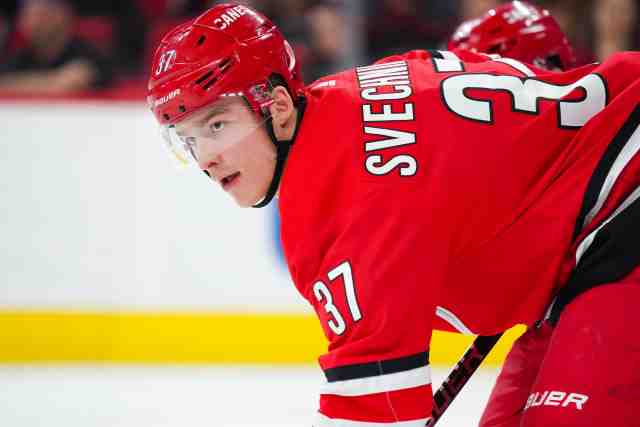With the start of the 2019-20 NHL season less than a month away, now seems like the perfect time to take a closer look at some up-and-coming youngsters poised to breakout this year.
Brady Tkachuk – Ottawa Senators
The Senators eased their prized rookie into things last season. Including deadline departures (Mark Stone, Matt Duchene, etc.), Tkachuk ranked 8th among Senators forwards in average ice time and 6th in aTOI at 5v5. That’s not going to be the case again next season. Tkachuk figures to be one of the leaders, as he should be.
If the ice time is there, Tkachuk should have no problem piling up the points. Tkachuk averaged 2.02 per 60 minutes at 5v5 last year, which was good for 89th. Put another way, he produced at a 1st line rate. A good portion of those points were goals. That’s hardly surprising given Tkachuk’s ability to generate scoring chances. He ranked 5th – only behind John Tavares, Auston Matthews, Timo Meier, and Brendan Gallagher – in expected goals/60 and 10th in overall chances/60.
If the efficiency is anywhere close to the level it was at a year ago, Tkachuk should pop off with the added responsibility coming his way.
Andrei Svechnikov – Carolina Hurricanes
Svechnikov’s story is very similar to Tkachuk’s. He was also extremely good at generating chances (39th) and expected goals (9th) as a rookie. Unfortunately, he had a couple of things working against him beyond just ice time.
First and foremost, linemates. It’s tough to be productive without real offensive talent around you, and Svechnikov didn’t have that. His two most common linemates – by far! – were Jordan Martinook and Lucas Wallmark. The former has never recorded more than 25 points in a season, and the latter registered 28 as a 24-year-old in one of his prime years.
Secondly, Svechnikov was really unlucky. He shot below 9% at 5v5. I think it’s fair to say that number should have been higher considering a) a lot of his shots came from quality locations and; b) if you watch him, he has a ton of power in his shot and a very quick release. His on-ice percentage of 5.97% was shockingly low even given the linemates he played with. Simply put, you don’t expect opposing goaltenders to post a .940SV% against your group over the course of a season. Even if he played *exclusively* with Martinook and Wallmark next season, I’d bet on that number going up.
Luckily, that won’t be the case. Sara Civian of The Athletic penciled Svechnikov into the top-6 at even-strength – and onto the top power play unit – in a recent article projecting what Carolina’s lines could look like this season.
If that’s the case, I don’t think 30 goals and 50+ points is an unrealistic expectation. Get on the Svechnikov bandwagon before it’s too late.
Jesper Bratt – New Jersey Devils
Bratt quietly had a very strong sophomore season with the Devils. When healthy, anyway. He produced 33 points in 51 games, which equates to 53 points over a full season. That’s a solid total, especially on a team as offensively challenged as the Devils.
A lot of that production came at 5v5, where Bratt averaged more points/60 (2.23) than stars like Nicklas Backstrom, Filip Forsberg, Mikko Rantanen, Tyler Seguin, and Vladimir Tarasenko, to name but a few. Again, he did this on an injury-plagued, offensively-starved team.
Realizing the issue at hand, the Devils were quite proactive adding talent to the organization this off-season – be it up front or on defense.
GM Ray Shero drafted Jack Hughes, traded for the KHL’s leading point-getter in Nikita Gusev, signed perennial 20+ goal scorer Wayne Simmonds, and added former Norris Trophy winner P.K. Subban on the back end.
Regardless of where Bratt ends up (top line with Hischier + Hall, 2nd line with Hughes + Gusev/Simmonds), there’s going to be high-end talent around him. He has more than enough ability to take advantage.
numbers via naturalstattrick.com
Follow me on Twitter @ToddCordell



